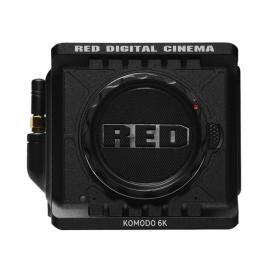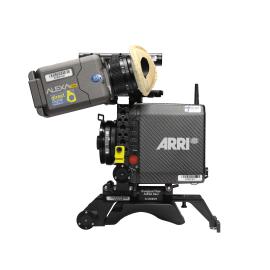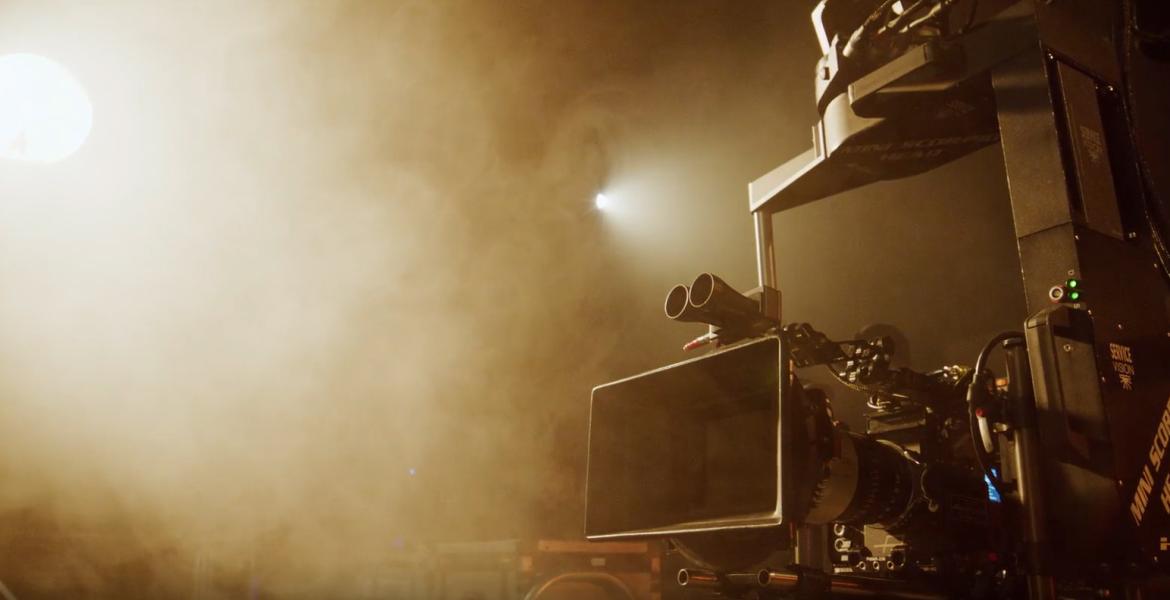
Short films are the ideal medium for serious filmmakers to get some practical production experience without a giant budget or extensive commitments in terms of project length.
However, short film production can easily run long (and expensive) if you or your team are working without suitable equipment for the scope of the project.
In this article, we'll explore the equipment necessary for shooting high-quality short films and bringing your creative vision to life on screen.
What do you need to make a short film?
There is no one-size-fits-all answer to this question. The essential or “best” equipment for any project will ultimately be determined by the project itself and the vision of you and your crew.
If we’re talking raw essentials, anyone can shoot video on their smartphone, but if you’re serious about your craft and the quality of the outcome, you’ll need significantly more than that - and we have some pro recommendations for various budget sizes and goals.
Short film equipment list
Below, you’ll find a general list of equipment needed to shoot your short film. We’ll cover each item in greater detail in the following guide.
- Cameras
- Lenses
- Storage
- SD cards
- SSDs
- Audio
- Audio interface
- Microphones
- Headphones
- Booms
- Camera support
- Tripods
- Gimbals
- Jibs
- Lighting kit
- Lights
- Reflectors
- Diffusers
- Computer
- Cables & carts
Cameras for shooting short films
Needless to say, your camera is the most important piece of kit - and there are a number of options available to you.
Our first pointer here… Choose a camera that is designed specifically for capturing video. Some mirrorless cameras can produce passable footage when operated well but will not stack up against the cinematic quality of footage caught on specialist equipment.
For low budgets: Blackmagic Pocket Cinema Camera 6K
For ultra-low-budget productions, we’d recommend the Blackmagic Pocket Cinema Camera 6K. This camera offers that huge Hollywood look in a tiny package.
With a high dynamic range, it rewards an experimental approach, perfect for newer filmmakers still trying to develop their style. It performs well in low light, produces impeccable organic colours (great for precise skin tones), and features an easy focus for efficient set-up.
As an alternative, we recommend the Canon R5 C. It carries the same rental fee as the Blackmagic Pocket Cinema Camera, but, with 8K capabilities, it punches well above its weight, pairing incredible resolution with a compact form factor.
For versatility: Red Komodo 6K
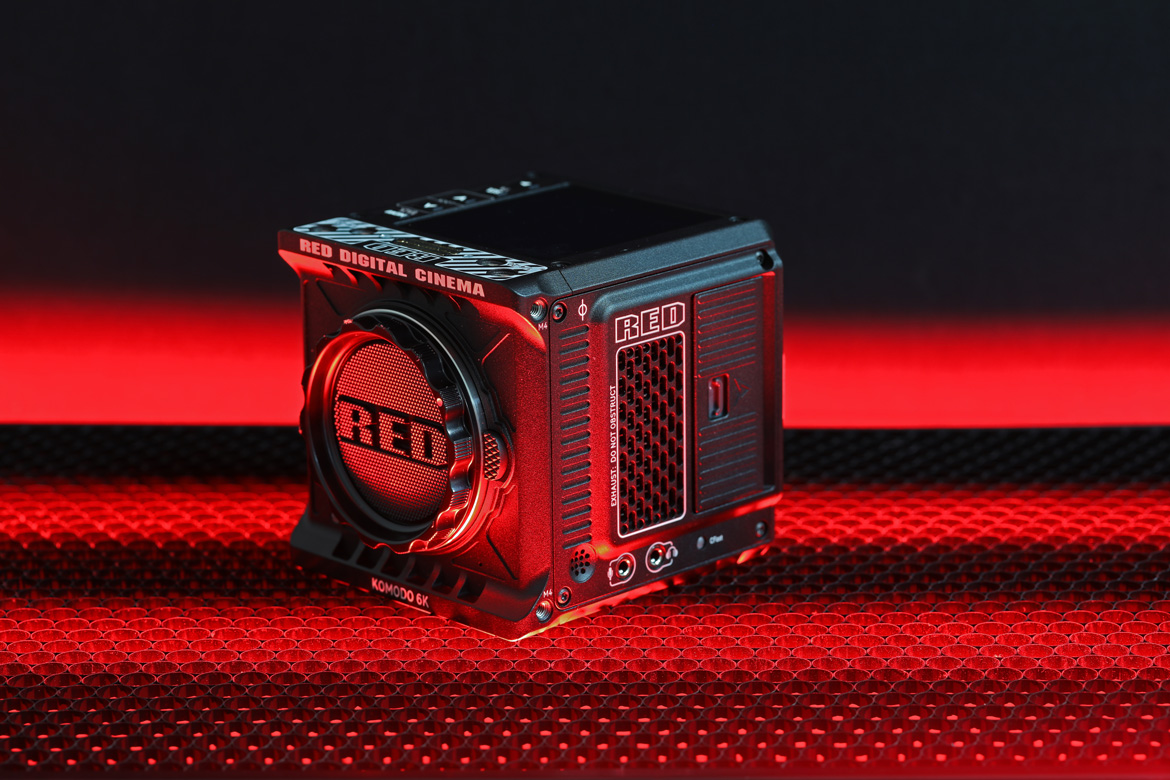
If you’re looking for the highest possible image quality for your money, the Red Komodo 6K should be a top contender.
This camera comes equipped with Red’s impeccable global shutter technology, meaning faster frame rates, the ability to shoot flash or burst with a broad spectrum of shutter speeds, and easy synchronisation.
The Sony FX9 is a slightly more affordable alternative. Unlike the Komodo 6K, it can’t capture stills, and a comparatively short ISO sensitivity range means you may be more reliant on artificial light, but it does offer some benefits.
For instance, the FX9 consumes less power, has a larger monitor, is IP-enabled, and boasts an integrated mechanical filter wheel for attenuating light intensity on the fly. This means less time fiddling with lights – and more time spent in the zone with your camera!
For documentary-style short films: ARRI Alexa Mini
The ARRI Alexa Mini is the go-to choice for documentary filmmakers seeking exceptional image quality and effortless operation. As the name suggests, it’s compact and lightweight, but what you won’t pickup from the name is this camera’s ability to film in any orientation, offering filmmakers unparalleled flexibility in capturing unique perspectives and storytelling angles.
Additionally, features like sealed electronics and built-in motorised FSND filters make it reliable for documentary shoots in unpredictable lighting and weather, ensuring that filmmakers can capturing authentic moments as they happen – even in less than stellar conditions.
For flawless presentation on big screens: Red V-RAPTOR 8K S35
The Red V-RAPTOR 8K S35 will likely be overkill for most projects. This camera is geared towards maxing out image quality when shown on large cinema screens. So, if you’re hoping to blow audiences away during a festival shorts block, this might just be the tool you’ve been looking for.
Lenses
There are two main categories of lens to choose from when assembling your kit: prime and zoom.
Prime lenses have to be moved manually towards or away from something to alter the angle of view, but, as the name suggests, zoom lenses enable cinematographers to zoom in and out from a static position.
They both have their place in a cinematographer’s arsenal:
- With reduced chromatic aberration and distortion, prime lenses can increase the production value of footage.
- For smaller productions without any tracking, a zoom lens can help provide smooth transitions using minimal support.
However, it’s important to note that camera lenses aren’t universal. They’re designed for compatibility with certain lens mount types.
Here are the lens mounts of the cameras recommended earlier:
- Blackmagic Pocket Cinema Camera 6K: EF & PL
- Canon R5 C: RF
- Red Komodo 6K: RF & PL
- Sony FX9: E
- Canon EOS C300 Mark II: EF
- ARRI Alexa Mini: PL
- Red V-RAPTOR 8K S35: PL
Prime lenses for short films
Ideally, you’ll have a whole set of prime lenses to shoot your short film, and as long as you’re renting your equipment, it doesn’t have to burn a hole in your pocket.

PL prime lenses
A three-lens set, such as this Carl Zeiss CO.2 Super Speed set (PL) would be a cost effective solution. Designed to work with full-frame and Super 35 sensors, these lenses are incredibly versatile in a practical sense, and thanks to smooth focus pulls, exceptional image quality and colour reproduction, from a creative sense too.
For bigger budgets and higher resolution cameras, the Sigma Full Frame-PL T1.5 6-lens set or Zeiss Supreme FF PL 5 Way lens set would be a better option. The former are designed for shooting in 6 to 8K and offer impressive image quality in a compact form factor, something you’ll appreciate if you have to travel to shoot locations partly by foot.
The latter offers silky smooth focus rotation and meticulous consistency across all lenses in terms of colour rendition, contrast, and general image characteristics. This ensures a professional, cohesive look, even as you switch between focal lengths.
EF & RF prime lenses
If you plan on using a camera with an EF type mount, the Canon CN-E lens set strikes a good balance between affordability and quality. It’s also an incredibly versatile set, complete with 4K telephoto lenses for capturing faraway subjects, and ultra-wide-angle lenses for capturing some epic, atmospheric landscapes.
Pushing your budget just a little further opens the door to a Carl Ziess CP-2 lens set. It’s a smaller set, but for those adopting a more conservative approach, with limited shot types, it’s worth sacrificing some flexibility for raw image quality.
If you’re going for a more naturalistic approach, 50mm lenses come close to representing how the human eye observes an environment, meaning something like the Canon RF 50mm can be used to create very naturalistic, paired back footage.
It’s relatively lightweight, lending itself to handheld filmmaking, and, like many 50mm lenses, is capable of creating a satisfying background blur to draw attention to an in-focus subject - perfect for portrait videography!

Zoom lenses for short films
Being that a single zoom lens offers such a variety of shooting options, a short, lower-budget production will likely only require one.
PL zoom lenses
Footage captured on high tech digital cameras may be a little too crisp for the aesthetic you’re aiming for. In this case, the Cooke Varotal 20-100mm Vintage will soften things up and add some warming characteristics to your scenes, such as gentle vignetting, flaring and bokeh.
If you’d rather avoid PL zoom lenses that affect the footage to such a degree, the Angenieux Optimo is a fantastic option. It might not be viable for ultra-low budget shorts, but for cinematographers who make the investment, the ergonomic, lightweight design of the Optimo pays dividends.
If you need a powerful and versatile zoom lens, perhaps one that could even sufficiently stand in for a prime lens, the Optimo is a wise choice.
EF & RF zoom lenses
In a ‘money’s-no-object’ scenario, any short film will benefit from a piece of kit like the Carl Zeiss CZ-2 70-200mm zoom lens. The extensive zoom capabilities of the CZ-2, as well as the compact form factor, make it a solid option for reducing fatigue while shooting a wide variety of extended scenes.
Alternatively, the Canon EF f/2.8L IS III USM lens offers the same expansive zoom range as the Carl Zeiss at a much smaller price point. It has exceptional image stabilisation, which can be a real scene saver if you’re shooting without extensive mounting equipment, and as it’s a weather-sealed lens, you’re not confined to shooting in immaculate conditions.
For more stylised scenes, you may want to consider a classic fisheye option, such as the Canon EF 8-15mm f/4L. While some will say they’ve had their day, nothing quite makes a close-up action sequence pop like a fisheye lens. When used thoughtfully, they can really help your short film stand out in the crowd.
Storage
Your film may be short once it leaves the editing room, but it will be built on hours upon hours of footage - and you need to be prepared with adequate storage.
When it comes to choosing an SD card, you should consider the length of your short film, how many days of shooting it will require, and, of course, the resolution you’re shooting in. For higher resolutions (4K +), you should look for cards with higher write speeds.
Treat UHS-3 as the minimum but aim for V30. Or, if you’re going all out with 8K footage, you might want to consider V90 cards.
Direct Digital offers a range of consumables, and we’re well-stocked with V30 SD cards of varying capacities:
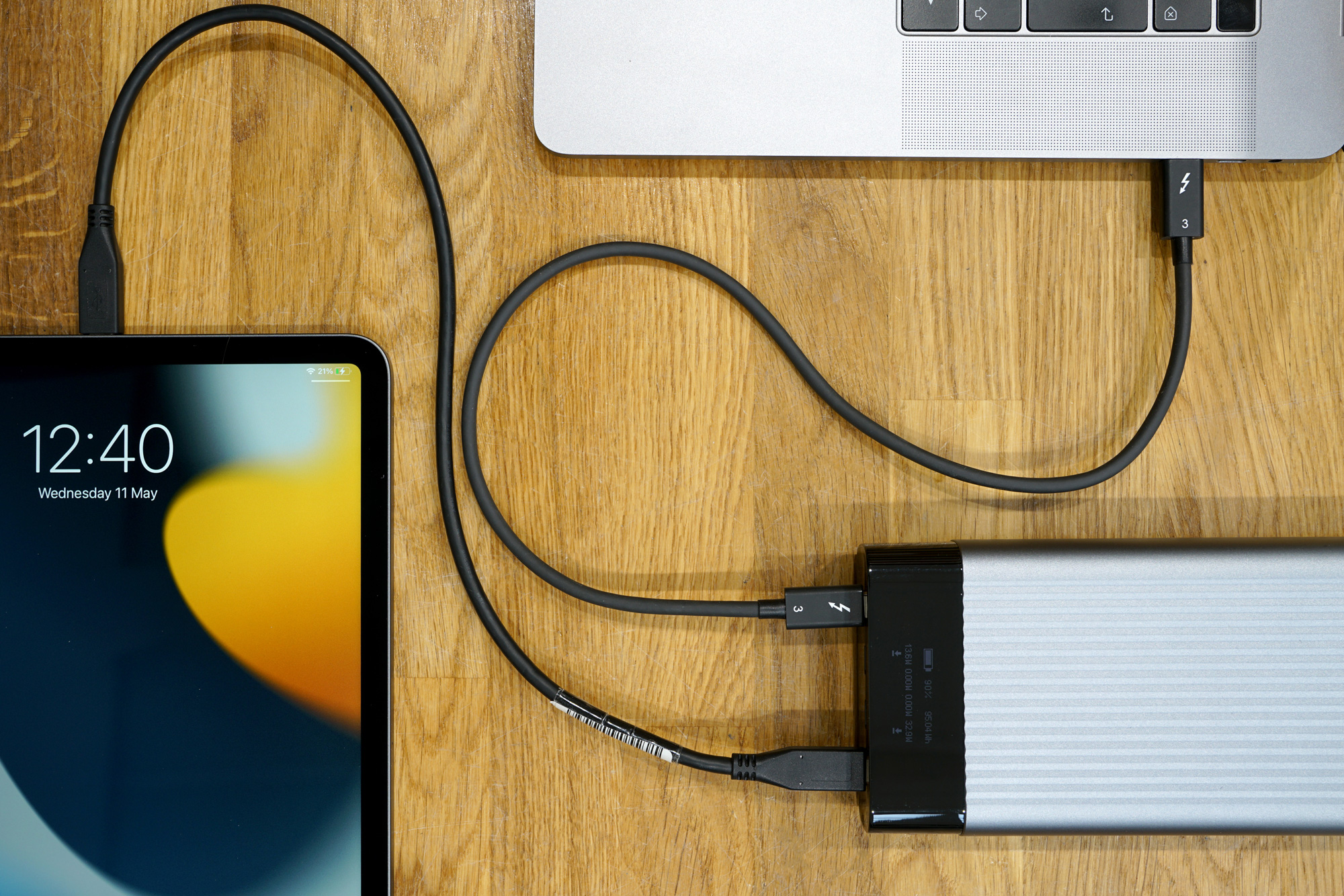
Our advice would be to choose the largest capacity card you can budget for.
We’d also recommend investing in a backup card. This way, you can shoot until one card is full, and while the footage is uploaded onto your laptop, you can get back to work with your second card, repeating the process until shooting wraps.
It’s good practice when shooting a short film to bring an SSD along for the ride too, especially if your laptop doesn’t have the most impressive internal storage spec.
For short, basic projects, you might get away with something quite modest, like a SanDisk Portable SSD 1TB, but for more advanced projects, you’ll want something with a larger capacity, such as the Samsung Portable SSD 2TB.
You should also consider the durability of your storage. If you’re shooting on challenging terrain, you may need a rugged design like the LaCie SSDs we stock.
Audio
Integrated camera mics are not exactly renowned for pristine sound-capture capabilities, so you’ll need some discrete microphones to handle the audio side of things.
Good microphones can be expensive, but you’d be surprised at the audio quality you can achieve with a well-placed, affordable shotgun mic on a boom, using something like the Zoom H6 as your interface.
For your shotgun mic, we recommend the Sennheiser MKH 461, and when it comes to your boom, you’ll need to decide what sort of length will be most suited to the style of short you’re producing.
We stock a 2m telescopic mini boom pole (great for ease of transport) and a 3m carbon fibre boom pole (great for slightly wider shots), both by RODE.
Headphones are another must if you want to hear audio as you shoot. You don’t need anything too flash - we’d recommend Sennheiser 201s.
Camera support
There are no rules that state you need camera support to shoot a good short film. If you’re using a camera with decent built-in stabilisation - you can achieve a lot shooting handheld. That said, discrete stabilisation is inexpensive and opens up a whole world of new possibilities.
If you’d rather start with a tripod and work your way up to more adventurous support options, we’d suggest browsing the Sachtler range. The Sachtler FSB-10 Fluid Video Tripod, for example, is affordable, robust, and with fluid damping systems for both pan and tilt motions, enables smooth, precise camera movement.
From there, we’d recommend checking out the Easyrig Vario 5 System lineup, as well as the DJI Ronin line. Even the more affordable options, such as the Easyrig Flow Cine or DJI Ronin RS2 can significantly expand your horizons, facilitating more dynamic and flowing cinematography.

And if you’re really pushing the boat out on your short film, you might want to incorporate some vertical camera motion into a scene here and there, which requires a jib. We’d recommend something robust, reliable, and lightweight – like the Libec Swift Jib 50.
Lighting
Before you consider any electrical lighting, it’s good practice to pick up a set of inexpensive reflectors to make the most of natural light. If this will be your first time using reflectors, you can experiment with and practise creative lighting techniques with a simple work light.
When it comes to synthetic lighting, the Kino FLO 2ft Celeb 200/201 LED kit is excellent for shooting on the go. Or, for a more advanced, larger panel (if you can handle the extra weight) try the Arri SkyPanel S120-C .

If extra weight isn’t an option, many of the products in the Aputure lighting range offer exceptional performance in more portable packages, making them a popular choice for shooting on location. The Light Dome Mini II is likely the one you’d go for to keep your kit manageable.
And if a dome sounds too unwieldy, softening and spreading an LED spotlight with a diffuser would be a more pack-friendly alternative.
Computers
Video editing is an intensive process for computers, particularly if you’re shooting in 4K or beyond. As such, a powerful and reliable computer is non-negotiable when shooting a short film.
A desktop will get you the most value for your money, but if portability is important to you, you’ll need a laptop. The question is… which laptop is best for your project?
Well, you’ll likely get more CPU and GPU muscle for your money with a PC, but Macs are the common choice throughout the film industry, as they’re designed specifically to support demanding creative tasks such as video editing.

This is why the only laptops we stock for hire are the MacBook Pro 15” with touchbar and the MacBook Pro 16” M1 Max. We also have your backup covered with a broad range of Samsung and LaCie SSD drives for hire.
Cables & carts
Cabling requirements are so vastly different from project to project that we can’t recommend any cables in particular, but we can advise on process.
Your first port of call should be to find out what supply the studio has. This will typically be 16amp, 32amp, or 63amp. Although, if shooting on location, at a location house, or using a generator truck, you may be dealing with a 13amp supply. If in doubt, ask for advice from those more familiar with the facilities you’ll be using.
Once you know what supply you’ll be working with, you can seek out the appropriate cables. If possible, pick up some spares, just in case.
With your cabling sorted, the last piece of the puzzle is a cart. Lugging around all the equipment discussed in this article is no mean feat, so we’d recommend renting a Foldit cart - or something of that ilk - to lighten the load and expedite setup and shutdown processes.
Or, if you want a cart that doubles as a workstation, you’ll need a Magliner or Inovativ cart.
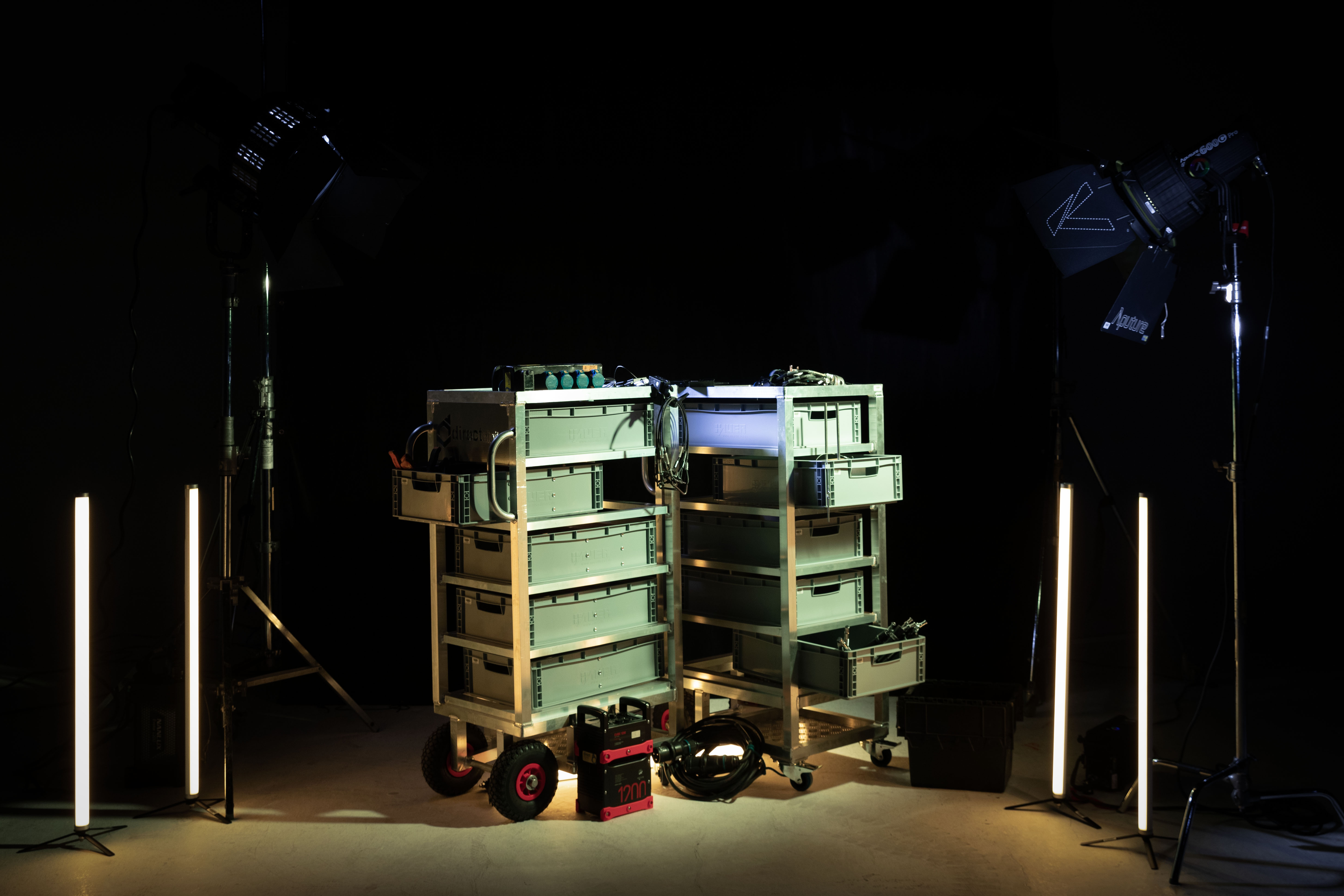
Final thoughts
Short films are often shot on shoestring budgets; however, assembling your kit still requires careful consideration. From cameras and lenses to audio gear and lighting, each piece has an impact on the outcome.
At Direct Digital, we offer a comprehensive range of pro equipment for hire so you can tailor your kit to fit various budgets and project needs. Whether you're looking for specific recommendations or need more information about the products mentioned in this article, contact us today.

